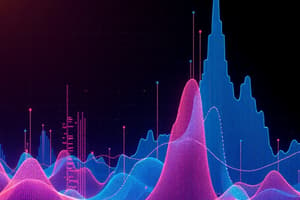Podcast
Questions and Answers
What is the main objective of grouping data?
What is the main objective of grouping data?
- To complicate numerical data
- To make numerical data harder to analyze
- To make complex numerical data easier to understand (correct)
- To increase the amount of data that needs to be processed
Which statistical method focuses on understanding trends, cycles, and seasonality in data over time?
Which statistical method focuses on understanding trends, cycles, and seasonality in data over time?
- Time Series Analysis (correct)
- Correlation Analysis
- Hypothesis Testing
- Regression Analysis
What technique is used to represent trends and patterns over time visually?
What technique is used to represent trends and patterns over time visually?
- Scatter Plots
- Pie Charts
- Bar Charts
- Line Charts (correct)
Which type of analysis is used to establish relationships between two or more variables and predict future outcomes?
Which type of analysis is used to establish relationships between two or more variables and predict future outcomes?
How does secondary analysis differ from primary data collection?
How does secondary analysis differ from primary data collection?
What does a scatter plot visualize?
What does a scatter plot visualize?
What is the main purpose of numerical data collection in statistical analyses?
What is the main purpose of numerical data collection in statistical analyses?
Which data collection method involves recording events or phenomena as they naturally occur without external intervention?
Which data collection method involves recording events or phenomena as they naturally occur without external intervention?
What is the primary goal of experimental research in the context of numeric data collection?
What is the primary goal of experimental research in the context of numeric data collection?
Which statistical analysis technique involves comparing product X and Y to determine customer preference?
Which statistical analysis technique involves comparing product X and Y to determine customer preference?
Which data collection method gathers subjective data usually based on self-reported information about beliefs, attitudes, behaviors, and opinions?
Which data collection method gathers subjective data usually based on self-reported information about beliefs, attitudes, behaviors, and opinions?
What technique is commonly used to analyze experimental data in numerical form?
What technique is commonly used to analyze experimental data in numerical form?
Flashcards are hidden until you start studying
Study Notes
Numerical Data Collection and Grouping
Numerical data collection refers to obtaining information through observations or measurements that can be quantified into numbers or numerical values. These data points often serve as the foundation for many statistical analyses and decision-making processes. Two key aspects of dealing with numerical data are its grouping and subsequent analysis, which involves various techniques such as classification, regression, and time series analysis. In this article, we will explore these concepts in detail and provide examples within the context of each subtopic.
Data Collection Methods
There are several ways to collect numeric data, including:
Surveys
Surveys involve collecting responses from individuals or groups using questionnaires or interviews. This method allows researchers to gather subjective data, usually based on self-reported information about an individual's beliefs, attitudes, behaviors, and opinions.
Experiments
Experimental research is conducted by manipulating variables to observe their impact on other factors. For instance, comparing product X and Y to determine customer preference. Statistical tests like t-tests and ANOVA are commonly used to analyze experimental data.
Observations
Observational studies involve recording events or phenomena as they naturally occur without external intervention. Researchers may use direct observation (physically observing subjects) or indirect observation (using tools or records).
Secondary Analysis
Secondary analysis is the reexamination of existing data collected by others for new purposes. Studies, reports, surveys, or any source of primary data can be considered secondary if it was not originally designed for the current research study.
Grouping Data
Data grouping refers to the process of categorizing numerical data into meaningful units called classes. The main objective of grouping data is to make complex numerical data easier to understand, interpret, and analyze by reducing the amount of data that needs to be processed. One common approach is frequency distribution tables, where the data is analyzed according to different intervals, also known as classes. For example, age could be divided into classifications like "Under 18", "18-25", "26-35" etc.
Statistical Analysis
Statistical analysis is the practice of collecting, analyzing, interpreting, and drawing conclusions from numerical data. It uses probability theory and statistics to draw realizations from large data sets, helping us understand patterns, trends, relationships, and differences. Some common statistical methods include:
- Hypothesis Testing: Analyzing whether there is sufficient evidence to reject the null hypothesis, which is generally assumed to be true unless proven otherwise.
- Regression Analysis: Used to establish relationships between two or more variables and predict future outcomes.
- Time Series Analysis: Focuses on understanding trends, cycles, and seasonality in data over time.
Real World Example
Suppose an online e-commerce platform wants to measure the impact of a price reduction campaign on orders received. By conducting a statistical analysis, the company can identify changes in the average order size before and after the campaign, allowing them to evaluate the success of the campaign.
Data Visualization Techniques
Data visualization techniques are used to represent and interpret data visually, making it easier for people to understand data and identify trends. Some common data visualization techniques include:
- Line Charts: These show trends and patterns over time.
- Bar Charts: Use rectangular bars with lengths proportional to the values they represent.
- Pie Charts: Show proportions of a whole.
- Scatter Plots: Plotting individual data points on a two-dimensional coordinate system, often used to visualize relationships between two variables.
Real World Example
A restaurant can use a pie chart to visualize the distribution of its sales across different menu categories to understand which dishes are its best-sellers.
In conclusion, numerical data collection is crucial for many fields such as social sciences, medicine, and business. Properly understanding our data allows us to make informed decisions, predict future outcomes, and identify trends. By employing efficient data collection methods, carefully grouping data, conducting thorough analyses, and choosing appropriate data visualization techniques, we can effectively analyze and communicate complex numerical information.
Studying That Suits You
Use AI to generate personalized quizzes and flashcards to suit your learning preferences.




